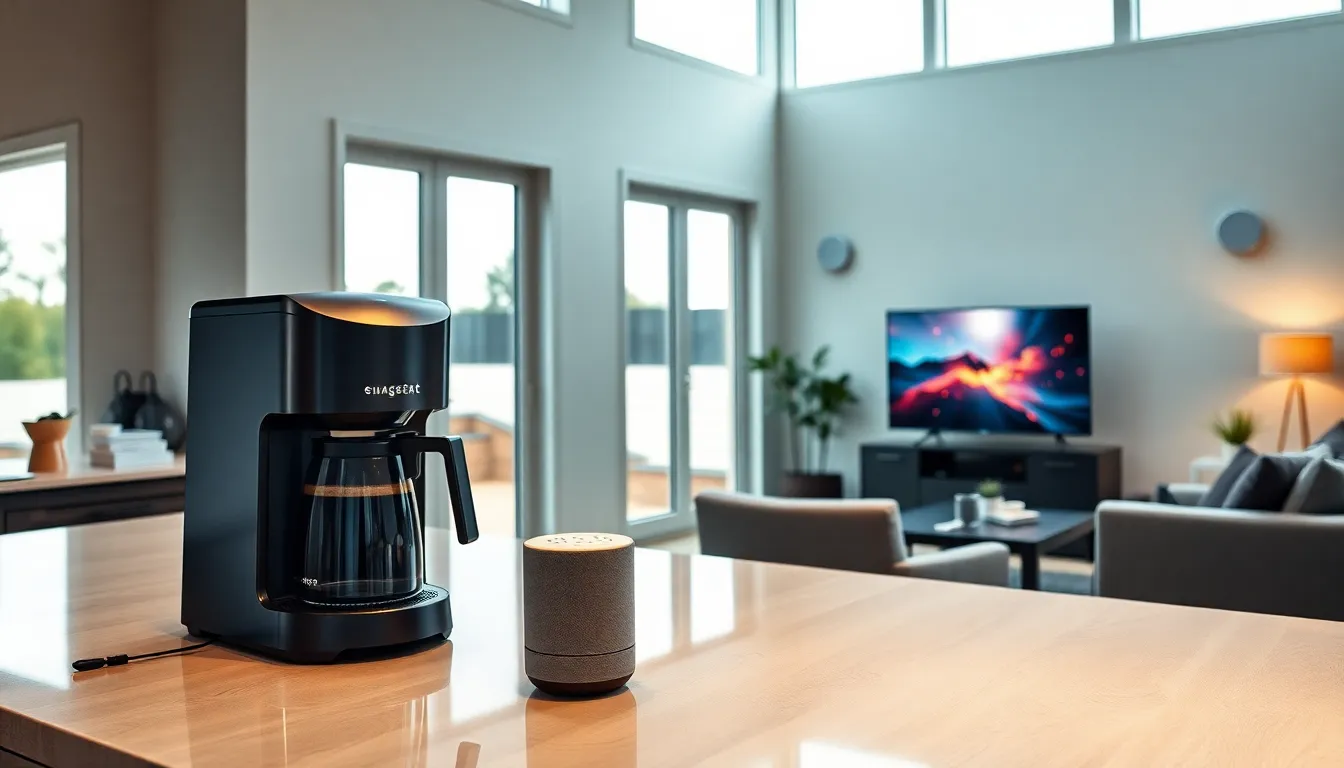Imagine a world where your coffee maker knows just when to brew that perfect cup, while your thermostat adjusts itself based on your mood—welcome to the realm of smart home integration software. This magical technology turns your house into a responsive, tech-savvy companion that’s ready to make life easier and a bit more entertaining.
In a time when juggling multiple devices feels like a circus act, smart home integration software swoops in to save the day. It connects everything from lights to locks, giving homeowners seamless control—all without the need for a PhD in tech wizardry. So, get ready to kick back, relax, and let your gadgets do the heavy lifting. Who knew home automation could be this much fun?
Table of Contents
ToggleOverview of Smart Home Integration Software
Smart home integration software enables seamless communication between various devices, making homes more efficient and user-friendly. This type of software often supports a wide range of appliances, including lighting systems, security cameras, and entertainment devices. Such compatibility allows homeowners to create a holistic ecosystem that enhances their living experience.
Using smart home integration software, users can manage multiple devices from a single interface. Many platforms offer mobile apps that provide remote access, enabling users to control their home environment anytime, anywhere. Enhanced automation features make it easy for devices to coordinate with one another. For instance, adjusting a thermostat can trigger lights to turn off, conserving energy and improving comfort simultaneously.
Various smart home integration solutions exist, including Amazon Alexa, Google Assistant, and Apple HomeKit. These platforms serve as central hubs, allowing devices from different brands to work together effectively. User-friendly interfaces simplify complex setups, promoting widespread adoption and integration.
Cost tends to vary based on functionality and brand. Many solutions offer free versions with basic features, while more advanced options may involve subscription fees. Investing in smart home integration software often leads to long-term savings through energy efficiency and reduced operational costs.
Continued advancements in artificial intelligence and machine learning drive the evolution of smart home integration software. These technologies increase personalization capabilities, enabling systems to learn user preferences over time. Future developments are likely to enhance security features and improve interoperability among devices even further.
Benefits of Smart Home Integration
Smart home integration software offers numerous advantages that enhance convenience and functionality in everyday living. Homeowners experience a more efficient lifestyle through advanced automation and control.
Enhanced Control and Automation
Smart home integration grants users centralized management of various devices. Homeowners can control numerous functions, from adjusting room temperatures to turning on lights, all from one mobile app. Automating routine tasks, such as setting timers for appliances, boosts efficiency. Users enjoy seamless interactions between devices, such as lights turning off when doors lock, providing an added layer of security. Scheduling devices to operate at specific times simplifies management and enhances comfort.
Improved Energy Efficiency
Energy efficiency improves significantly with smart home integration. Homeowners can monitor and manage energy consumption effectively. Smart thermostats adjust heating and cooling based on occupancy, reducing unnecessary energy use. Integration allows for coordinated device operations, such as lights dimming automatically during the night. Data from energy usage reports helps users gain insights into their habits, promoting mindful consumption. Overall, implementing smart home integration leads to lower utility bills and contributes to environmental sustainability.
Popular Smart Home Integration Software Options
Numerous smart home integration software options provide seamless connectivity between devices. Each of these software solutions enhances convenience and efficiency in daily life.
Software A
Amazon Alexa serves as a leading smart home integration platform. This software supports various third-party devices, making it easy to control lighting, heating, and security systems. Users can issue voice commands or set routines, allowing for effortless interactions with multiple devices. Alexa also connects with home automation applications, enabling customized settings for personal preferences. These features contribute to a more integrated and responsive living environment.
Software B
Google Assistant stands out due to its robust capabilities and compatibility. It controls a wide array of devices, from entertainment systems to smart appliances. Users interact through voice commands, mobile apps, or smart displays, providing flexibility in operation. This software allows scheduling and automation, enhancing overall comfort and energy efficiency. With machine learning, Google Assistant adapts to user habits, creating a tailored smart home experience.
Software C
Apple HomeKit offers a user-friendly option for those in the Apple ecosystem. It integrates easily with various devices, ensuring compatibility across brands. Users manage settings through the Home app or Siri voice commands, supporting a streamlined approach. Invoking automations enhances daily routines, while secure connections provide peace of mind. HomeKit prioritizes privacy, making it appealing for security-conscious homeowners.
Key Features to Look For
Look for compatibility across a wide range of devices when selecting smart home integration software. Software that supports various appliances such as lighting systems, thermostats, and security cameras enhances usability. A unified control interface provides ease of access, enabling management from a single mobile app.
Consider automation capabilities that allow devices to interact seamlessly. Features like scheduling tasks and coordinating actions among devices improve energy efficiency and comfort. Voice command functionality further enhances convenience, offering users another layer of control.
Evaluate security features to safeguard personal data and privacy. Software with robust encryption and user authentication safeguards sensitive information. Interoperability among different brands and systems remains crucial for a cohesive smart home experience.
Prioritize user-friendliness in software design. Intuitive interfaces and simple navigation enable users of all technical backgrounds to engage effectively. Regular updates and customer support options help maintain system functionality over time.
Assess the ability to monitor energy consumption from the software interface. Insights into usage patterns allow homeowners to make more informed decisions about their consumption, potentially leading to lower utility bills.
Cost also plays a significant role in decision-making. Some software solutions offer free versions with basic functionalities, while advanced features might require paid subscriptions. Balancing cost with offered features is essential for maximizing investment value.
Review user feedback and community engagement to gauge the software’s effectiveness and reliability. Active user communities provide support and tips, enhancing the overall experience. This insight helps identify popular features and potential issues before committing to a solution.
Challenges and Considerations
Deployment of smart home integration software presents several challenges for users. Compatibility issues arise frequently, as not all devices connect seamlessly. Diverse manufacturers create fragmentation, requiring homeowners to identify compatible products for a cohesive system.
Security risks cannot be overlooked. Cybersecurity threats can compromise personal data when devices are connected to the internet. Users must prioritize software with robust security features to safeguard their private information.
User experience also poses challenges. Complexity in setup and navigation can frustrate homeowners. Selecting user-friendly software ensures easier access to features and functions.
Cost considerations remain essential. While some software solutions offer free versions, premium features often carry subscription fees. Evaluating the overall value against specific needs helps users make sound investments.
Technical support is another crucial aspect. Users may encounter issues when integrating devices, necessitating reliable assistance. Access to responsive customer service can make a significant difference in user satisfaction.
Lastly, energy management capabilities matter greatly. Many software solutions include tools for monitoring consumption, but not all provide comprehensive analytics. Homeowners should seek programs that enable them to understand their usage patterns and promote energy efficiency effectively.
Smart home integration software represents a significant leap toward a more automated and efficient lifestyle. By simplifying the management of various devices, it empowers homeowners to create a personalized living environment that enhances comfort and convenience. With options like Amazon Alexa, Google Assistant, and Apple HomeKit, users can select solutions that best fit their needs.
As technology continues to evolve, these systems are becoming more intuitive and capable, allowing for seamless communication between devices. The potential for energy savings and improved security further underscores the value of investing in smart home integration. Embracing this technology not only simplifies daily routines but also contributes to a more sustainable and connected home.






